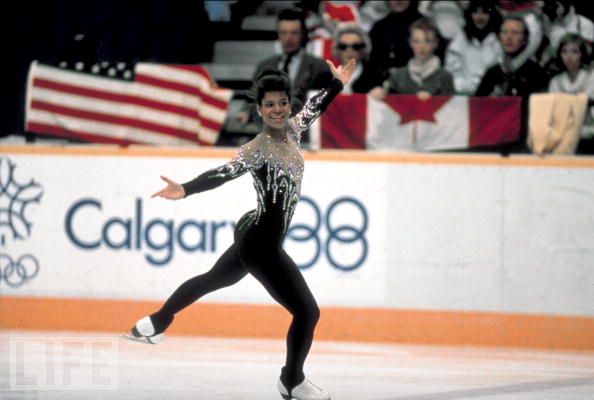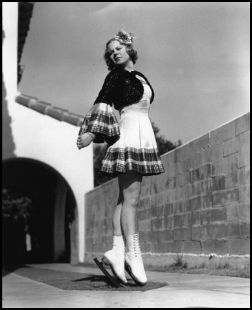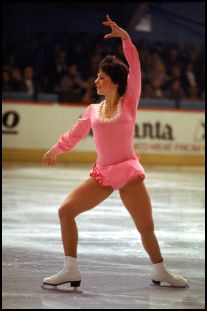Fun Fact #1: Female figure skaters are required to wear skirts and men must wear “full-length trousers: no tights.”
Note: This isn’t true anymore; “this rule was repealed in 2004, allowing women to wear tights, trousers, or unitards” (http://www.frogsonice.com/skateweb/faq/rules.shtml)
Sonja Henie, of Norway, is credited with introducing the short skirt to women’s figure skating. She won gold medals in 1928, ’32, and ’36:
According to Abigail Feder, in her article ” ‘A Radiant Smile from the Lovely Lady’: Overdetermined Femininity in ‘Ladies’ Figure Skating”, the International Skating Union (ISU) introduced a rule requiring that women wear skirts after they were scandalized by Debi Thomas’ unitard at the 1988 Olympics:
 (source)
(source)
An NPR slide show explains:
Today, according to the ISU, figure skating’s governing body, “Ladies must wear a skirt. The Ladies dress must not give the effect of excessive nudity inappropriate for an athletic sport. Men must wear full-length trousers: no tights are allowed and the man’s costume may not be sleeveless.”
So, just to be clear, the performance of femininity and masculinity, as defined by the ISU, is required if one is to be a competitive figure skater… all skills aside.
—————————–
Fun Fact #2: People used to make their costumes by hand; today they are high fashion.
The 1976 Olympics were the last in which figure skating costumes were mostly handmade. Here Dorothy Hamill competes in a costume her mother made for $75:
Today, costumes frequently cost thousands of dollars. Michelle Kwan and Nancy Kerrigan both competed in Vera Wang (who, in 2009, was inducted in the U.S. Figure Skating Hall of Fame for her designs). Kerrigan:
Lisa Wade, PhD is an Associate Professor at Tulane University. She is the author of American Hookup, a book about college sexual culture; a textbook about gender; and a forthcoming introductory text: Terrible Magnificent Sociology. You can follow her on Twitter and Instagram.



Comments 57
Teresa — February 24, 2010
I had no idea about the change from homemade costumes to high fashion, but I am pretty sure that the ISU repealed the skirt rule from figure skating in 2004? I remember Irina Slutskaya skating in the 06 Olympics in a unitard-like outfit:
Oddly enough, for ice dance they still require a skirt!
pmsrhino — February 24, 2010
OMG A UNITARD!!! My poor retinas!!! DX
I mean seriously? It's just silliness. How does what they wear detract from their athletic ability? Is it really THAT distracting? (Answer: Apparently)
Shay — February 24, 2010
Hmmm... I remember the Kerrs used to do a Scottish ice dance routine wearing a dress and a kilt... I wonder if this is why they switched to the country/swing 'folk dance' for this Olympics?
Deaf Indian Muslim Anarchist — February 24, 2010
I hate how the focus is on the fashion rather than on the sport itself. We should be focused on the SPORT and the TALENT of the skaters-- who cares what they're wearing?
God, I hate people.
Jessica — February 24, 2010
Lisa! I love this blog and read every single entry with great feminist glee! However, first time commenting because in checking out the NPR slideshow after reading this post, I was surprised to see how liberal you were with interpretation of the Dorothy Hamill caption:
+"It was one of the last Olympics where costumes were still homemade," not the last, and there was nothing about 1976 costumes being 'mostly' handmade.
+"Her Olympic dress, made by a friend's mother," not her own mother.
+"This photo is from the previous year's World Championships," and so may or may not be the same $75 handmade dress.
Misrepresentation of the info to better make a point, or just a tired misinterpretation? I assume the latter! because I am in love with your blog and want it to have all the best facts and info all the time! Just please don't make me wonder if info is being skewed elsewhere.
That said, the point here is fantastic. I watched figure skating for years and years (mostly 1990s) and could have told you that yes, the ladies are always in skirts... but never would have guessed that was REGULATION!!!! What madness. Arg, ridiculous! And making sure men aren't in sleeveless tops ensures their manliness?
Sage — February 24, 2010
It might help to know that before Vera Wang was a famous designer she was a competitive figure skater. She even made it into Sports Illustrated. If any designer could get figure skaters to wear her designs, it's a designer who understands figure skating.
Miriam Heddy — February 24, 2010
NPR connects the shocking unitard to Surya Bonali while Feder attributed it to Debi Thomas. Both are black skaters. It would be interesting to look at the intersection of race and gender here in terms of acceptable costuming. If the unitard was a problem when black women wore it, *why* was it a problem? To what extent is that related to the dominant white belief that black women are not as feminine and therefore needed to be corrected for in costuming lest they seem mannish?
hypatia — February 24, 2010
["Female figure skaters are required to wear skirts and men must wear “full-length trousers: no tights.”"]
It was just commented on by an announcer at the Olympic women's short program that the "unitard" is in fact allowed, it's just rare to see it, as there was a (female) competitor in one.
These rules seem to apply specifically to the "ice dance" and not the individual or pairs competitions
lyndsay — February 24, 2010
I was watching ice dance the other night and one of the commentators noted that a female skater had taken TRAINING in being "more womanly", she continued that the training taught this high-performace athlete to "smile more, move her arms and accentuate herself"
Why would we waste any other athlete's time with this junk? For the rest of my time watching ice dance, all I could see were the gender presentation challenges. Why are men never lifted, and I wonder how long it will be before we see an ice dance pair with a female lead.
This was not made any better when CTV commentators were basically gender policing Johnny Weir for seeming queer and speculating if he had pink or lady gaga posters in his room in the athlete's village. It is pretty hurtful that this would come up, of all places, at a Vancouver Olympics.
Alexicute — February 24, 2010
Yeah i don't think the rule goes for the pairs comp. Tatiana Volosozhar and Stanislav Morozov of Ukraine skated the short program in these Olympics. They wore matching blue unitards only hers had a keyhole cut out between the boobs and one on the lower back(naturally). This picture was actually taken at Cup of China ISU Grand Prix of Figure Skating 2009 at Beijing Capital Gymnasium, but thy wore the same outfits. The CTV announcers mocked them pretty mercilessly for looking like Na'vi refugees from Pandora. While these costumes do look a bit non-traditional, the long lines made their leg extensions look really good.
[IMG]http://i5.photobucket.com/albums/y164/skinthekat/figureskaters.jpg[/IMG]
As for Johnny Weir, I really don't know where they (the announcers) get off calling him flamboyant in a sport where nearly everyone is wearing sequins. I mean, they called him Lady Gaga listening....doesn't pretty well everyone listen to lady gaga atm? Even if they don't want to.
Alexicute — February 24, 2010
what no html??? very well have a link to the image.
http://i5.photobucket.com/albums/y164/skinthekat/figureskaters.jpg
I Research The Weirdest Things — February 24, 2010
This annoys, but does not surprise, me. In the course of writing a piece of fiction, I discovered that the ISU also codifies gender-rules in their definition of pairs skaters -- a pair is "one lady and one man".
Similar pairs (made of two men or two women) are not eligible to compete in any officially-sanctioned pairs events -- if two fe/male skaters wanted to compete in the Olympics as a pair, they're completely out of luck.
(Also, my family loved Suryaa Bonaly. We still talk about her routine to this day.)
Cancer Cowboy — February 24, 2010
In truth, as much as II would like to see a same-sex pair in the Ice Dance competition, the Olympics are split into genders for a reason. And at risk of sounding ignorant or intolerant, the male and female bodies are simply capable of different extremes. If there were a group with two men, then the jumps and lifts would more than likely be higher scoring than with a pair of a man and a woman, while a group of two women would have higher scores elsewhere. At face value the rule of 'One man one woman' is silly and absurd, but there are obvious physical reasons behind it.
Abigail — February 25, 2010
Lifts, throws, and so on in pairs figure skating seem to reward large size dichotomies. I suspect this might have something to do with why the women tend to be so much younger than their partners, and sometimes about half their size. Of course, it's not that hard to find people of the same sex who are very different in size, so I doubt physical differences really make heterosexual pairings completely necessary.
One of the ice dancing pairs, the Kerrs (mentioned above) are brother and sister and very close in height; the NBC commentators mentioned during the compulsory dance that this can be a drawback for them because it makes it so much more obvious when they aren't in sync. I haven't seen the long program yet, but it's interesting to hear that it works to their advantage in other moves.
Johnny Weir gets attention because he shows a very colorful personality off the ice. The stuff about Lady Gaga and Cher posters in his room is not speculation; they were only repeating the things he said to reporters himself. He's not as well known for his actual skating as some of the others are, though he performed well enough that I imagine that will change.
Oh, and ditto what some of the other commenters said about pants being allowed for women now. I didn't know the bit about men needing sleeves. I know they ignore that in pro skating; there's one guy in particular (Candeloro, maybe?) whose gimmick was to gradually strip down to a bare chest during performances.
Abigail — February 25, 2010
Okay, so I just discovered that YouTube has some nice video of male/male pairs doing throws.
Johnny Weir/Rudy Galindo: http://www.youtube.com/watch?v=AzM4LM8NsbY&feature=related
http://www.youtube.com/watch?v=zUgu_-VeDcg
Johnny Weir/Stephane Lambiel: http://www.youtube.com/watch?v=P8P-XpohHUU
Jeffrey Buttle/Evan Lysacek: http://www.youtube.com/watch?v=j1TSf8f7vt4
Looks pretty nice to me, considering they were just playing around.
Bella the Bunny Girl — February 25, 2010
As I recall from Calgary, the "shocking" costume that led to the regulation wasn't the unitard, it was Katarina Witt's high cut leg, sparkly crotch, feathers on the butt show girl costume - it was just too much for a competetive number. The rule may seem stodgy, but the intent was to prevent sexualized costumes being used to distract from the athletic aspects. Too bad they don't go further and ban sequins, glitter and illusion fabric, but TV loves those things too much.
As for Johnny Weir (Love. Him.) it's like someone said 'can figure skating be any gayer?' and he took it as a personal challenge. He encourages and seems to thrive on that sort of reaction, I have my fingers crossed he'll be invited to perform his Poker Face routine at the gala.
Meera — February 26, 2010
The sexualizing costumes worn by female competitors are actually a major reason that I've stopped watching figure skating. I don't want to feel like I'm front-row at Moulin Rouge when I watch a sports competition.
ketchup — February 26, 2010
I was just watching Tuesday's women's short program at the Vancouver Olympics and thinking about what changes with the unitard versus the skirt. First, the skin-hugging unitard sexualizes the body much more, so it's not good for either sex. Secondly, for the women, the skirt dress is much more feminine and graceful, being much more congruent with several of the moods brought about the different styles of music.
@Alexicute: "This picture was actually taken at Cup of China ISU Grand Prix of Figure Skating 2009 at Beijing Capital Gymnasium, but thy wore the same outfits. The CTV announcers mocked them pretty mercilessly for looking like Na’vi refugees from Pandora."
Well-deserved by what we see in the picture. And another example where her body becomes more sexualized than if wearing a feminine short skirt, ironic as that may be.
Wearing one glittering, feminine short skirt dress, Yu-na scored a record-breaking short program on Tuesday. It's nice to see that femininity can be so beautifully blended with unmistakable strength, exquisite competence, and unyielding concentration, because I would be the first to agree that it's often just hammered down as a more or less disguised synonym of fragility and incompetence.
This ice-skating clothes post is yet another example of misplacing the problem of gender inequality in the fact that we have two genders, masculine and feminine. This fact should be celebrated in various cultural formats (but without inequality or oppression).
ketchup — February 26, 2010
@fangirl:(Finally, your repeated insistence that there are ONLY TWO GENDERS OMG completely and totally ignores the lived experience of people who consider themselves outside or in between the gender binary. Or is it totally okay in your world to just pretend agender or androgynous people don’t exist?)
A person who is not messed up socio-psychologically will develop their masculine or feminine gender for their respective male or female sex. Therefore, trying to do away with the human gender binary itself is harmful, since it is an inherent aspect of human existence. It's not a question of pretending humans don't have all kinds of mental and cultural problems about gender.
ketchup — February 27, 2010
@fangirl: The thing is, adding a skirt doesn’t cover anything more than a unitard does
...
@fangirl: Actually, a unitard is less sexualizing, if you ask me
...
Regarding ballet: I made no such statements; clearly, someone who’s arguing in favor of A UNITARD isn’t advocating for “pant suits” for Swan Lake. I’m not saying that female figure skaters should not wear skirts, just that they are inherently no more modest or less sexualized than unitards.
======
You were saying that short skirt dresses sexualize more the female skaters, therefore, they should wear a unitard. I am pointing out that actually both sexualize the body, and the down side of a unitard is that it loses a great deal of feminity, and it can even sexualize the body more.
The point about the tutu is that it shows exactly the same amount of "skin" as a short skirt dress for skaters. So, if you claim a short skirt dress for a skater is overly sexualized, then it is also for ballet dancers, and they should all wear unitards. I think this is a ridiculous proposition because a ballet tutu is one of the most archetypical outfits for femininity, not hyper-sexuality. And yet, there is a lot of "skin" being shown. Thus a perfect example where the fact that there is a skirt and it flips in a voyeristic fashion is not determinant to how much sexualizing is actually done, because there are so many other elements that are part of the equation.
Secondly, the short skirt does cover more than a unitard, otherwise they would be the same thing and they are not. The short skirt completely changes the main formal line of the garment from the waist to the upper thighs. It's obvious what is being covered there (front and back). And it's obvious and important that we see it as a *skirt* and not as a long belt. It's not only a question of visual covering, but of social meaning about clothes and gender.
=====
@fangirl: "(Ballerinas are dancers as well as actresses: they are playing defined roles as characters. )"
It doesn't change the fact that a ballerina could play the very same Swan Lake role in a tutu, a unitard, or a checkered pantsuit.
The question I was also addressing is just how much sexualizing is appropriate for a costume? If any sexualizing is a problem, then clearly the Swan Lake ballerina costume should be a checkered pantsuit (the least sexualizing option of all three). But that's gross and stupid. For the skaters, we disagree on what's more sexualizing in an inappropriate measure. I would be against the unitard for the reasons I have explained. Just as I found the Canadian's blue costume on Thursday way too excessive, and showing too much skin. It was a short skirt with a bra top practically. I'm against showing the midriff. Keep it a short dress. And the same thing with the choreography in figure skating, some of it just clearly veers towards the sexually cheap as a way to "spice up" the performance, given that it lacks more artistic sophistication otherwise.
ketchup — February 27, 2010
Ketchup: Anyways, it’s interesting that you believe without question anyone who claims that they don’t have any problems that affect gender. I think it’s a pretty naive stance to understanding people. I have the impression that you wouldn’t apply this same rationale to people who claim they have changed from homosexuality to heterosexuality or the other way around.
Fangirl 10:51 pm
Your narrative of change is where I lose you.
=========
It's simple, from my experience, people like you, who extort others to believe without question what "transgender" people tell them, are completely against listening to and believing people who claim they have changed sexual orientation (in the axis of hetero to homo). It's not the change element, it's the exortation to believe without question someone else's interpretation of their own experience.
From what I understood, you believe "transgender" people were genetically formed that way just because transgenders claim they feel uncomfortable with the gender that is the natural outcome of their sex.
I think there are a million social, personality, and inter-personal elements and cumulative experiences that could make a child feel uncomfortable about gender (and anything else for that matter), and it has nothing to do with being born that way, of being wired that way; it can be explained post-birth. So while I can listen to the genetically determined transgender claim, I don't think that explains it.
Just as I do not believe that sexual orientation that departs from a constructive adult heterosexual one is wired before birth. (The opposite of constructive here would be violent, adult would be pedophile, and heterosexual would be homosexual).
Correct me if I am wrong but you don't believe people who claim they went from heterosexual to homosexual or vice-versa, even though they swear that is their experience, and you have never lived it yourself.
hi — March 4, 2010
!!!!!!!!!!!!!!!!!!!!!!!!!!!!!!!!!!!!!!!!!!!!!!!!!!
galii — March 5, 2010
ok
galii — March 5, 2010
????????????????????????????????????????????????????????????????????????????????????????????????????????????????????????????????????????????????????????????????????????????????????????????????????????????????????????????????????????????????????????????????????????????????????????????????????????????????????????????????????????????????????????????????????????????????????????????????????????????????????????????????????????????????????????????????????????????????????????????????????????????????????????????????????????????????????????????????????????????????????????????????????????????????????????????????????????????????????????????????????????????????????????????????????????????????????????????????????????????????????????????????????????????????????????????????????????????????????????????????????????????????????????????????????????????????????????????????????????????????????????????????????????????????????????????????????????????????????????????????????????????????????????????????????????????????????????????????????????????????????????????????????????
Austin — March 7, 2010
I usually don't comment here (and frankly, probably won't in the future given the transphobia in this post), but Isabelle Pieman of Belgium wore a unitard for her short program in this year's Olympics (http://2.bp.blogspot.com/_FW86_jO7k_A/S4m3mNZG3UI/AAAAAAABjOA/rbcPE-pQVwU/s1600-h/Isabelle+Pieman+of+Belgium+1.jpg). And as far as I can tell, not too many people were scandalized - although, maybe they (i.e. American media) just didn't pay attention to her because she's not from the U.S.
Guest Post: Policing Gender in Figure Skating » Sociological Images — March 31, 2010
[...] differences in figure skating are also institutionalized in the form of costume requirements. Women are required to wear dresses, while men are not allowed to wear leggings or sleeveless [...]
Anonymous — December 21, 2010
i hate this website
Anonymous — February 19, 2011
This web site does not have any good info. I hate this web site
Anonymous — May 18, 2011
i love this web page
Anonymous — May 18, 2011
i tink its sexy and steemimg like my boobs
None of Your Business — February 1, 2012
Actually, women are allowed to wear pants/unitards...it's a pretty big trend right now, especially among girls who do pair skating.
cool sponge — December 12, 2013
im a sponge
ohfrock — December 4, 2018
Thanks For sharing useful Information. I appreciate your content. your blog is very impressive and knowledgeable. Keep sharing!
ohfrock — December 6, 2018
Thanks for sharing Useful Information. i appreciate your Content. i love your Blog. keep sharing!